The Bulldozer Review: AMD FX-8150 Tested
by Anand Lal Shimpi on October 12, 2011 1:27 AM ESTThe Test
To keep the review length manageable we're presenting a subset of our results here. For all benchmark results and even more comparisons be sure to use our performance comparison tool: Bench.
| Motherboard: |
ASUS P8Z68-V Pro (Intel Z68) ASUS Crosshair V Formula (AMD 990FX) |
| Hard Disk: |
Intel X25-M SSD (80GB) Crucial RealSSD C300 |
| Memory: | 2 x 4GB G.Skill Ripjaws X DDR3-1600 9-9-9-20 |
| Video Card: | ATI Radeon HD 5870 (Windows 7) |
| Video Drivers: | AMD Catalyst 11.10 Beta (Windows 7) |
| Desktop Resolution: | 1920 x 1200 |
| OS: | Windows 7 x64 |
Windows 7 Application Performance
3dsmax 9
Today's desktop processors are more than fast enough to do professional level 3D rendering at home. To look at performance under 3dsmax we ran the SPECapc 3dsmax 8 benchmark (only the CPU rendering tests) under 3dsmax 9 SP1. The results reported are the rendering composite scores.

As our first heavily threaded, predominantly FP workload we see the FX-8150 come out swinging. A tangible upgrade from the Phenom II X6, the 8150 is hot on the heelds of the Core i5 2400, however it is unable to compete with the 2500K and 2600K.
Cinebench R10 & 11.5
Created by the Cinema 4D folks we have Cinebench, a popular 3D rendering benchmark that gives us both single and multi-threaded 3D rendering results.
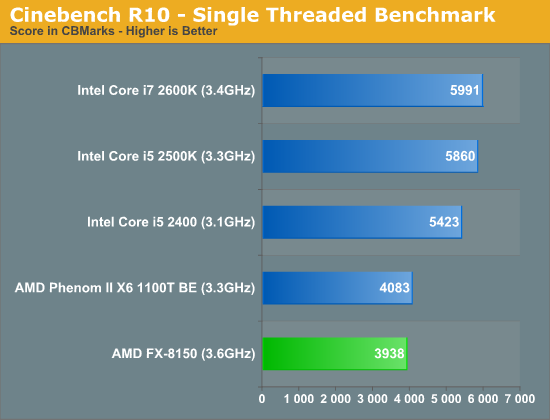
As I alluded to earlier, single threaded performance is going to be a bit of a disappointment with Bulldozer and here you get the first dose of reality. Even considering its clock speed and Turbo Core advantage, the FX-8150 is slower than the Phenom II X6 1100T. Intel's Core i5 2500K delivers nearly 50% better single threaded performance here than the FX-8150.
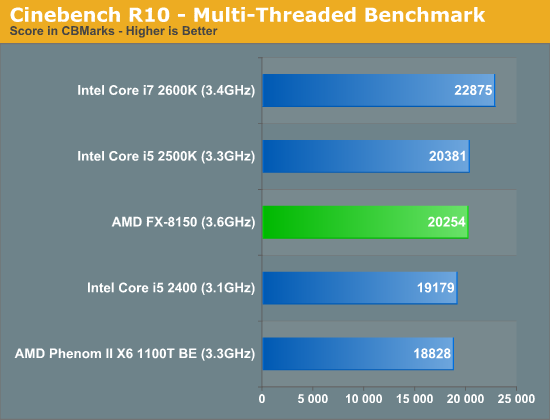
Crank up the threads and the FX-8150 shines, finally tying the 2500K at a comparable price point.
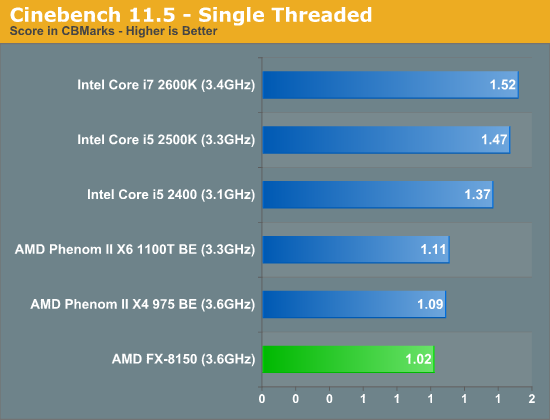
Even with more modern workloads, the FX-8150 isn't able to compete in single threaded speed. Here the 2500K is 44% faster.
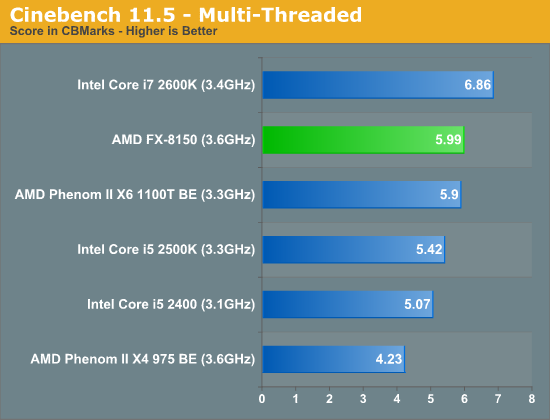
Modern multithreaded workloads however do quite well on Bulldozer. The gains over the old Phenom II X6 1100T are unfortunately not as large as we would expect them to be.
7-Zip Benchmark
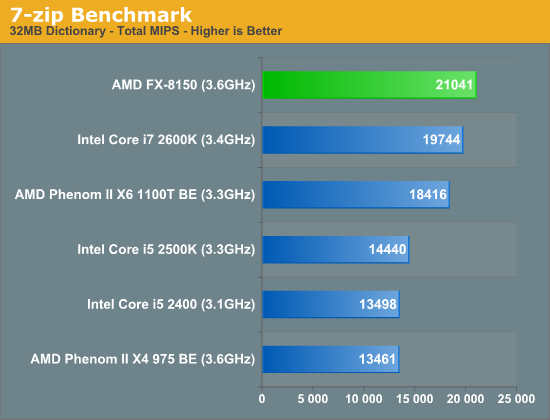
Heavily threaded workloads obviously do well on the FX series parts, here in our 7-zip test the FX-8150 is actually faster than Intel's fastest Sandy Bridge.
PAR2 Benchmark
Par2 is an application used for reconstructing downloaded archives. It can generate parity data from a given archive and later use it to recover the archive
Chuchusoft took the source code of par2cmdline 0.4 and parallelized it using Intel’s Threading Building Blocks 2.1. The result is a version of par2cmdline that can spawn multiple threads to repair par2 archives. For this test we took a 708MB archive, corrupted nearly 60MB of it, and used the multithreaded par2cmdline to recover it. The scores reported are the repair and recover time in seconds.
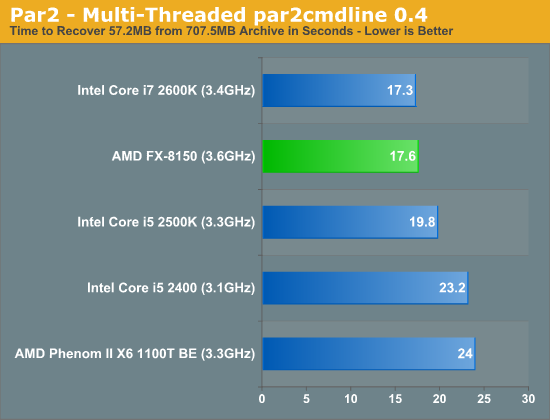
Once again, throw more threads at the processor and the FX-8150 can outperform the Core i5 2500K.
TrueCrypt Benchmark
TrueCrypt is a very popular encryption package that offers full AES-NI support. The application also features a built-in encryption benchmark that we can use to measure CPU performance with:
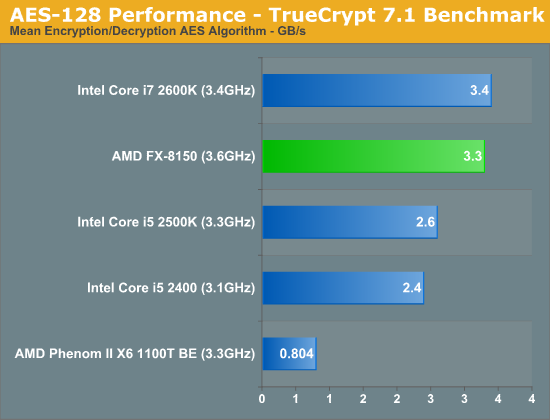
Bulldozer adds AES-NI acceleration, a feature that wasn't present in the Phenom II X6. As a result the FX-8150 is among the fastest at real time AES encryption/decryption, second only to the 2600K. Intel's artificial segmentation using Hyper Threading comes back to haunt it here as the 2500K is significantly slower than the 8-threaded beast.
x264 HD 3.03 Benchmark
Graysky's x264 HD test uses x264 to encode a 4Mbps 720p MPEG-2 source. The focus here is on quality rather than speed, thus the benchmark uses a 2-pass encode and reports the average frame rate in each pass.
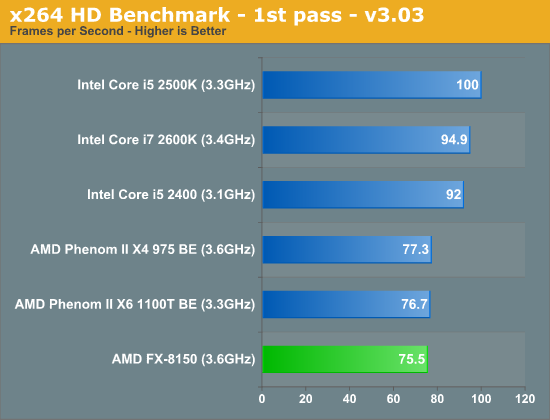
As I mentioned earlier, the first pass of our x264 HD benchmark is a lightly threaded task. As such, the FX-8150 doesn't do very well here. Even the old Phenom II is able to inch ahead of AMD's latest. And Sandy Bridge obviously does very well.

The second pass is more thread heavy, allowing the FX-8150 to flex its muscle and effectively tie the 2600K for first place.
AMD also sent along a couple of x264 binaries that were compiled with AVX and AMD XOP instruction flags. We ran both binaries through our x264 test, let's first look at what enabling AVX does to performance:
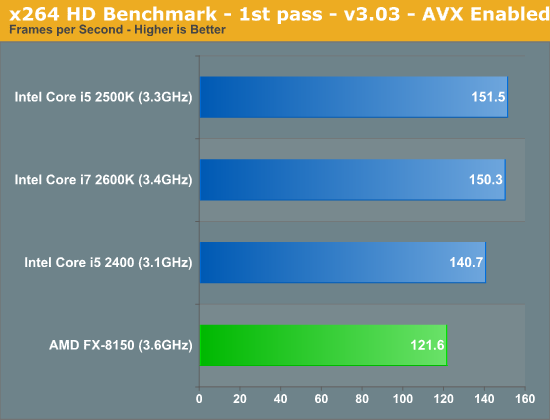
Everyone gets faster here, but Intel continues to hold onto a significant performance lead in lightly threaded workloads.
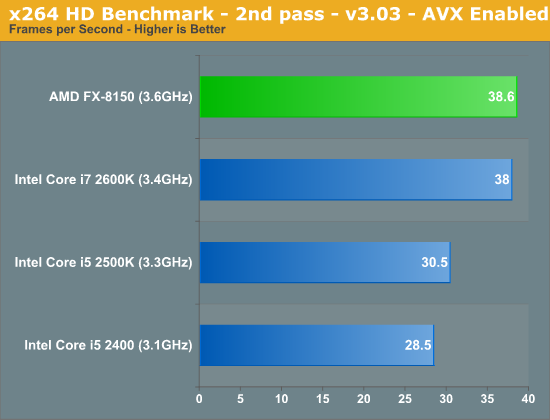
The standings don't change too much in the second pass, the frame rates are simply higher across the board. The FX-8150 is an x86 transcoding beast though, roughly equalling Intel's Core i7 2600K. Although not depicted here, the performance using the AMD XOP codepath was virtually identical to the AVX results.
Adobe Photoshop CS4
To measure performance under Photoshop CS4 we turn to the Retouch Artists’ Speed Test. The test does basic photo editing; there are a couple of color space conversions, many layer creations, color curve adjustment, image and canvas size adjustment, unsharp mask, and finally a gaussian blur performed on the entire image.
The whole process is timed and thanks to the use of Intel's X25-M SSD as our test bed hard drive, performance is far more predictable than back when we used to test on mechanical disks.
Time is reported in seconds and the lower numbers mean better performance. The test is multithreaded and can hit all four cores in a quad-core machine.
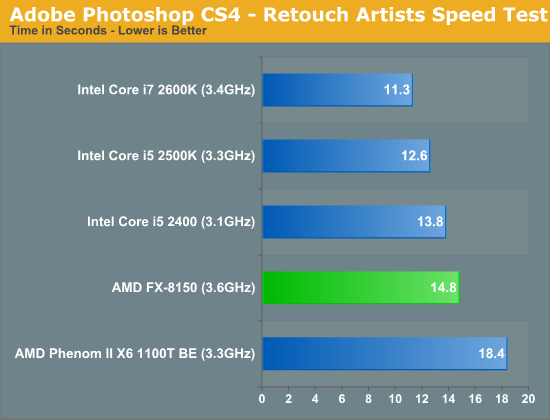
Photoshop performance improves tangibly over the Phenom II X6, unfortunately it's not enough to hang with the enthusiast Sandy Bridge parts.
Compile Chromium Test
You guys asked for it and finally I have something I feel is a good software build test. Using Visual Studio 2008 I'm compiling Chromium. It's a pretty huge project that takes over forty minutes to compile from the command line on a dual-core CPU. But the results are repeatable and the compile process will easily stress more than 8 threads on a CPU so it works for me.
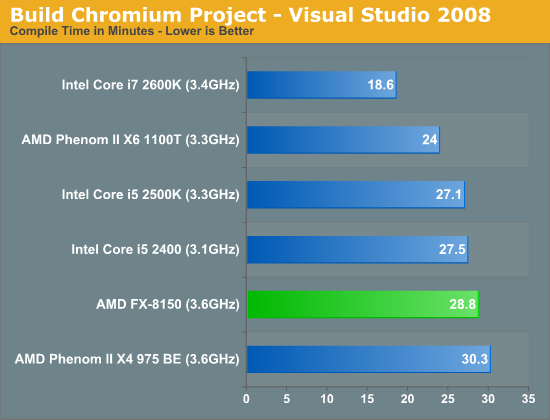
Our compiler test has traditionally favored heavily threaded architectures, but here we found the Phenom II X6 1100T to offer a tangible performance advantage over Bulldozer. While AMD is certainly competitive here, this is an example of one of those situations where AMD's architectural tradeoffs simply don't pay off—not without additional clock speed that is.
Excel Monte Carlo

Our final application test is another win for AMD over the Core i5 2500K. The victory is entirely a result of Intel's Hyper Threading restrictions though, the eight-thread 2600K is able to easily outperform Bulldozer. Either way, AMD delivers better performance here for less money.










430 Comments
View All Comments
Iketh - Wednesday, October 12, 2011 - link
AMD Exec a year ago: "We about ready to release BD?"AMD Engineer: "Soon. At 4ghz, we're actually slower per thread and using double the power than Phenom at 3.4ghz, but we'll get there..."
AMD Exec: /gquit
lyeoh - Wednesday, October 12, 2011 - link
Bulldozer reminds me of the P4/Prescott for some reason ;).High clock, high watts, but not enough performance.
Might be faster in parallelizable tasks but most people with such tasks would just buy more computers and build large clusters.
Iketh - Wednesday, October 12, 2011 - link
The processors are popping up on Newegg now... the 8120 for $220 and 6100 for $190vol7ron - Wednesday, October 12, 2011 - link
Sigh... I made the mistake in buying a Prescott. Not to mention I bought an "E" batch, which ran even hotter and weren't as overclockable.actionjksn - Wednesday, October 12, 2011 - link
Yeah I had one of those hot potato's too. Back then we thought Intel was finished.just4U - Thursday, October 13, 2011 - link
ckryan, you stated you were blown away by the 2500K yes? It's odd you know.. I've owned a PII 920, PII 1055, PII 955 (tested lots of lowbie $60-80 parts from AMD to) .. also used a i7 920, i7 955 i5 2500k i7 2600k (my most recent one) and .. I am not blown away by any of them..Last time I was blown away by a cpu was the Q6600..(before that the A64 3200+) since then other cpu's have been better but not so much so that I'd say that it was night and day differences.
CeriseCogburn - Wednesday, March 21, 2012 - link
Ok that was some enormously skilled twisting and spinning. BD is an epic failure, period. I can't envision anyone with any needs, need, or combo thereof choosing it.\It's so bad amd lied about it's transistor count.
Forget it, it's an epic fail and never anything more.
jiffylube1024 - Wednesday, October 12, 2011 - link
Ugh, BD is quite the disappointment. The power consumption is absolutely through the roof -- unacceptable for 32nm, really!With that said, I am very intrigued in the FX-4100 4-core 3.6GHz part. This should be the replacement for the Athlon II 2-4 core series, and I'm very interested to see how it does vs ~3 GHz Athlon II X2's, X3's and X4's.
yankeeDDL - Wednesday, October 12, 2011 - link
Wow ...I'm blown away.
I have been waiting for BD's reviews and benchmarks for months. I have waited for BD for my new rig.
I have used AMD for the past 8 years and I am ... was convinced that it always offered, by far, the best price/performance ratio for entry-level, mid range PCs.
I am a still a big fan of AMD ... but I have to stand corrected. BD is a POS. Longer pipelines? Didn't they learn anything from Pentium 3/4 debacle?
A Phenom II X6 is almost always better than BD, even in power consumption. Come on: if BD had come out shortly after the Phenom I could see it as an incremental improvement, a new baseline to build upon. But it took AMD years to come out with BD ... and this is the result? Disappointing.
I mean, betting everything on higher clock frequencies? At 4GHz? It's no wonder that Intel's IPC improvements are crunching BD: IPC is all about doing more with the same power, clock speed is all about throwing more power to do the same faster ...
Boy. This ruined my day.
yankeeDDL - Wednesday, October 12, 2011 - link
By the way, no matter how AMD slices it, I see the FX-8* as a 4-core CPU. A glorified ohene, but still a 4-core.If I was AMD, I would have considered a fair goal to obliterate the i5-2500 performance with the new FX-8 family, instead it comes short most of the times.
What were they thinking?